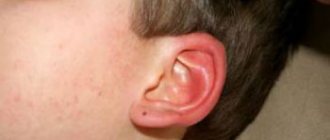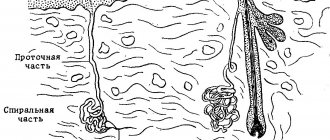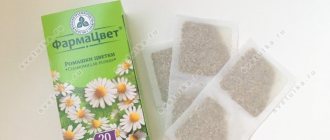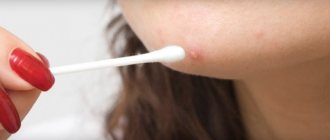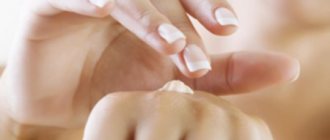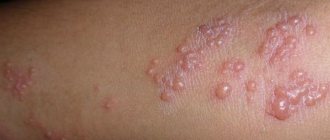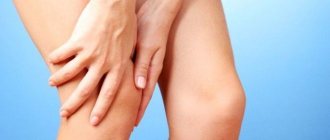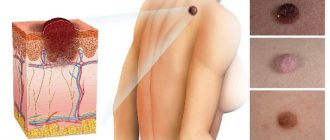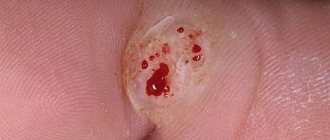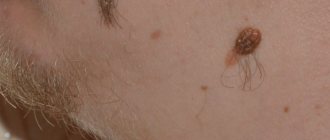The process of renewal of the epidermal layer of skin occurs throughout a person’s life. It is natural and healthy people do not notice its progress. But sometimes a malfunction of the sebaceous glands in tandem with metabolic disorders in cellular structures is accompanied by increased dryness of the skin. As a result of this, the process of scale rejection becomes visible and passes with the appearance of itching and various rashes. This condition most often indicates the development of skin pathology or disease of internal organs.
Signs
There are several signs that you can tell if you have dry skin:
- Peeling.
- Itching.
- Tightness.
The most delicate and sensitive area on our face is the forehead. It takes the brunt of the blow, so the first place you can see these signs is on the forehead, since this area is susceptible to drying out. In order to prevent peeling of the skin in this area, it is worth using special skin care products. It is necessary to purchase moisturizing cosmetics to prevent these three unpleasant signs of dry skin in the near future.
Why does a person's skin dry out?
Peeling of facial skin can occur due to frostbite in winter
Peeling is a natural process of death of epidermal cells, which, under the influence of certain factors, becomes too pronounced and can be difficult to cope with on your own.
Most often, dry facial skin is a consequence of a lack of moisture in the tissues. The forehead begins to itch and peel for the following reasons:
- washing with hard or hot water;
- use of inappropriate soap, washing gel, aggressive decorative cosmetics;
- traumatic peeling;
- unfavorable weather conditions - strong wind, frost, UV rays;
- dry air in the room, blown with hot air from the air conditioner.
With proper skin care, peeling caused by external causes is quite easy to get rid of.
If dry skin is not moisturized, the deep layers of the dermis will be damaged. As a result, cracks, areas of keratinization, thickening will appear, severe itching will appear, and after 30 years the first wrinkles will become noticeable.
Problems with the endocrine glands cause skin problems
Internal factors can also influence the condition of the epidermis:
- deficiency of nutrients, in particular collagen, omega-3 polyunsaturated fatty acids, vitamins A, E, C;
- allergic reaction;
- dermatological diseases (dermatitis, seborrhea, mycoses);
- long-term use of medications;
- endocrine disorders;
- gastrointestinal diseases.
Redness in the area of the nasolabial triangle is often caused by a runny nose and inflammatory processes in the nose.
Causes
But in order to completely remove this problem from life, it is still worth understanding the problem. Why does the skin on my forehead peel? The reasons are as follows:
- The first and most important point is that soap dries out the skin. You should wash your face only with warm or cool water, as very hot water will harm your facial skin.
- If you like to use a heater in the cold season, then you should remember one important thing: it also leads to oxygen starvation of your body, or rather the skin of your face.
- Sudden climate changes are especially dangerous for the skin. In cold weather, try to use special cosmetics for the care and resuscitation of the skin, as the skin also tends to dry out and crack. At this time of year, use less decorative cosmetics, and it is better to completely remove them from your winter cosmetics bag.
Even if you do a full range of facial skin care and take into account every little detail, you must not forget about the problems of the body itself. Diseases of internal organs can affect a person’s appearance. There are a number of reasons why dry skin may occur in women and men at different ages.
Causes of the disease
The causes of flaky skin on the back are directly related to the methods of treating this disease. Only by identifying and eliminating the cause of the disease can you get rid of this problem.
All dermatologists agree: peeling and itching of the skin of the back cannot be ignored. Changes in the skin are a signal of the appearance of infectious diseases.
Why does the skin on my back peel and itch? You may have:
- Dry seborrhea is a disease in which the upper layer of the epidermis is depleted, and the skin peels and itches;
- Xeroderma - characterized by itching, localized in one area of the back. Upon closer examination of the area that itches, the following are noticeable: reddened spots and flaky skin;
- Allergy – the body’s reaction to medications, foods or hygiene products;
- Neurodermatitis - has neuro-allergic roots. Expressed in the form of small plaques, which, after bursting, turn into spots;
- Fungal diseases and psoriasis.
The above reasons can cause skin disease not only on the back, but also on other parts of the body. It can peel and itch: the stomach, arms and legs, face.
Excessive or infrequent bathing, exposure to chemicals, dry back skin or taking narcotic drugs can also trigger the disease.
Hormonal disorder of the body
It leads to a number of health problems in women. In addition to cycle disruptions, depression, nervous breakdowns, today’s topic (dry skin) also joins this list of troubles. Due to a lack of hormones in the body, the skin becomes less elastic, loses its tone and flakes. But this problem can also arise with age during menopause. Estrogen in our body decreases critically, as a result of which the body suffers greatly and endures great stress. At such moments, wrinkles and age spots begin to appear on the skin, and it loses its elasticity.
Facial skin peels due to improper cell renewal
Hyperkeratosis is a condition when skin cells divide with increased activity, but the natural process of exfoliation is disrupted. The surface layer of the epidermis is covered with an uneven thick layer of dead cells. In some places they peel off faster, and in others they adhere more tightly to the skin.
You can observe peeling in certain areas of the face: at the sides of the nose, on the cheeks, near the lips. With hyperkeratosis, the penetration of moisturizing cosmetic components into the skin is difficult, so applying a greasy or moisturizing cream will not solve the problem. With this condition, closed comedones and inflammation often appear.
How to solve a problem
For hyperkeratosis, exfoliating cosmetics and procedures will help. Use acid lotions, peeling rolls and film masks. Homemade acid-based products that you buy in a regular store can be used all year round. But you should stock up on sunscreens with high SPF, otherwise there is a high risk of developing pigmentation.
What acids to look for in exfoliating cosmetics:
- Lemon – found in citrus fruits, promotes the gradual exfoliation of horny skin scales, antioxidant. Subject to the rules of use, it brightens the skin and eliminates pigmentation.
- Almond – suitable for oily skin. Exfoliates well and has an antibacterial effect. Dissolves sebaceous plugs, eliminates comedones.
- Glycolic - due to the small size of the molecules, it easily penetrates the stratum corneum of the epidermis. Most effective in solving the problem of hyperkeratosis. Gradually normalizes the natural processes of skin renewal. May cause irritation, so choose home remedies with a low concentration of glycolic acid - around 4-5%. This acid will only have an exfoliating effect at a pH level of 3-4.
It is better to postpone professional exfoliating procedures until the fall, when solar activity decreases. Among salon procedures, pay attention to laser resurfacing and superficial peels.
Skin diseases
There are various diseases that will help you understand why dry forehead appears. These are pathologies such as allergic reactions, fungus, psoriasis, seborrhea, dermatitis. In these cases, the skin not only peels off, it turns red, itches, and rashes may also appear, which may have a different etiology. If you are concerned about these symptoms, do not delay visiting a dermatologist. At the initial stage, it will be easier for him to understand what happened and what is the reason. If you consult a specialist in a timely manner, there is a chance for a quick recovery.
Treatment of constant itching of the back, skin on the back: methods
My back itches
Constant itching of the skin on your back can become a serious and painful problem. To avoid or alleviate it, it is enough to know several ways to quickly eliminate this unpleasant symptom:
- Patting and tapping the itchy area can relieve the itch, but never scratch.
- Apply a cool compress to the irritated area.
- You should take a cool shower.
- Do not wear clothes made of synthetic or woolen materials. They may irritate the skin.
- Use moisturizers for dry and flaky skin.
- The pharmacy also sells over-the-counter antihistamine and steroid creams that can help relieve itching.
Important: If the itching on the back is constant, and also if there are additional symptoms (rashes, fever, headache), you should consult a therapist or dermatologist. It is important to determine the root cause.
Conventionally, three groups of reasons can be distinguished:
- General (insect bites, dry skin, poor hygiene, excessive sweating, allergies, infection, hormonal changes).
- Dermatological.
- Associated with various pathologies.
Depending on what is causing your itching, you may be referred to a specialist for further evaluation and specific treatment. And for those who want to help themselves now and eliminate itching, you can use the best advice from herbalists:
- Rub sandalwood oil into your skin. It cools and soothes the skin.
- You can rub your back with Menovazine. Peppermint oil, which is part of the product, has a good sedative.
- Experts also recommend drinking a few drops of aloe vera juice in the morning on an empty stomach. It nourishes and moisturizes skin cells.
- A lotion made from flaxseed oil and lemon juice helps effectively - 1 part lemon juice and 3 parts flaxseed oil, mix and rub.
- It is useful to apply cream with chamomile or calendula to the affected areas.
These ingredients have anti-inflammatory properties that can reduce swelling of the skin, as well as rashes and bumps, and help the healing process.
What skin changes occur in adulthood?
Peeling skin on the forehead is more often a problem for women than men. One of the reasons for peeling skin lies in the fact that the structure of a woman’s internal body changes, and, as mentioned above, changes occur. There is only one conclusion: you need to take care of your skin from adolescence. Perhaps this way you can avoid a number of reasons why problems with the skin on the forehead arise, and not only.
If you use cosmetics correctly, you can avoid a lot of discomfort on your face. This means that you first need to learn how to use scrubs and lotions. If you do everything at random and do not follow the rules, this can lead to the following problems:
- Peeling of forehead skin.
- Hyperemic areas of skin appear on the face. This indicates that some cosmetic product was carefully rubbed into the face.
- Peeling may go away, but for a short period, after a while it appears again.
One of the factors may be that you use low-quality cosmetics. In this case, try replacing it. If this does not help, then it is best to contact a dermatologist so that he can help identify the cause of the problem in the early stages.
Causes of rough skin
1. Lack of moisture in the body. Moreover, this factor may be associated not only with insufficient water consumption directly. Perhaps there is a process of water-salt metabolism in your body. Then, even with sufficient fluid intake through tea, soup, juicy fruits, vegetables and water, the tissues will not be able to receive enough of it. More precisely, it will not be able to be fully absorbed and become nutrition for other vital processes. This aspect becomes one of the reasons for the slowdown in metabolism, which leads to a lack of nutrients for cells. The result is expressed, among other things, in the appearance of roughness of the skin, its tightness and increased dryness.
2. Lack of vitamins, minerals, and a general decrease in the body’s immunity become factors that can cause severe peeling and the appearance of goosebumps on the surface of the skin. This is possible both on a temporary basis - during seasonal vitamin deficiencies, and in the long term due to a stable lack of specific nutrients.
3. Fasting or diet. Any period of food shortage provokes accelerated processes of processing useful components, which are deposited in a kind of storage in the body and cease to enter the cells. More precisely, they enter there in smaller quantities than with the usual diet, which is due to the body’s protective reaction in response to fasting. If the diet is built incorrectly or lasts too long, then the effect of skin peeling is not long in coming.
4. Insufficient care. In some cases, roughness of the skin occurs due to insufficient hydration of the surface tissue, which happens even with regular use of moisturizer. In this case, it is important to give your skin a full scrub at least once a month so that the nutrients in your lotions and gels have access to the upper layers of the epidermis, helping to maintain its smoothness.
5. Pellagra is a disease caused by a lack of nicotinic acid in the body. Often the disease occurs due to insufficient consumption of vitamin PP or disruption of the processes responsible for its absorption in cells. Adults aged 20 to 50 years are most prone to this disease. Often a significant trigger for pellagra is excessive consumption of light carbohydrates and lack of fiber in your diet.
Proper skin care
In most cases, people's skin has its own individual structure, and can react differently to each drug. If your forehead is red and flaky, you should consult a dermatologist about the best drug to take. It could also be some kind of additives. But if visiting a dermatologist is a last resort for you, try using regular folk remedies for facial skin care.
- To prevent dry skin from disturbing your peace, you should drink at least two liters of clean water a day.
- Before washing your face, fill a mug with water and let it sit for a while, as tap water is chlorinated and also dries out your skin.
- Water should definitely be at room temperature, since too hot or too cold irritates the epidermis, which affects the result of washing.
- Choose cosmetics for yourself that do not contain alcohol.
- The face towel should be soft and should not rub your face like sandpaper. This causes harm to your skin.
- Buy yourself a moisturizing toner and use it every time after washing your face.
- It also doesn’t hurt to use creams or oils to moisturize the skin.
- Make face masks only from natural products and only on your own.
- You can buy vitamins A and E separately at the pharmacy; they will help you keep your skin in good condition. These vitamins can be added to the cream.
- Exfoliate your face periodically. This is a very effective procedure, many women use it.
Why does a rash appear on the back in an adult?
A rash on the back is not considered an independent disease; it is an accompanying symptom of more serious pathologies in the body. In most cases, rashes occur due to allergic reactions caused by some pathogen. Allergies can appear suddenly.
Most often, reactions occur to certain products and low-quality materials, for example, fabrics containing 100% synthetic material.
Rashes can occur due to poor personal hygiene. For example, neglecting water procedures or using low-quality shower products. Often the disease develops due to excessive insulation, which results in prickly heat.
Frequent stress is also accompanied by rashes. But the causes of the rash may not be completely harmless. In many cases, unpleasant symptoms indicate internal problems in the body.
To accurately determine the cause of stain formation, it is worth examining each individual case in detail.
Allergic reactions
An allergic rash on the back is one of the most common phenomena. Reddish spots (urticaria) appear not only on the back, but also on the chest. Allergies are accompanied by certain diseases. In addition, during allergic reactions, swelling can be observed, especially in the morning.
In such cases, intoxication of the body occurs, due to which it weakens.
The pathogens are different:
- Some food products (citrus fruits, exotic fruits, honey)
- Dust;
- Animal wool;
- Poor quality fabrics;
- Personal hygiene products.
If a person guesses about the allergen that led to the formation of the rash, it is worth eliminating it immediately. Allergic rashes are treated with antihistamines.
It is important not to confuse allergies with some types of lichen, so you should consult a dermatologist to determine the correct cause of the rash.
Hormonal disorders
Hormonal imbalances are a common occurrence in both men and women. Most often they occur during puberty or during pregnancy. In such cases, red rashes appear on the chest, back, arms and face.
In addition, due to insufficient functioning of the sebaceous glands, a rash on the back may be accompanied by the appearance of ulcers.
Hormonal rashes should be treated under the supervision of a doctor; anti-inflammatory drugs and immunomodulators are usually used.
Infectious diseases
Often the cause of the rash is infectious diseases. Such pathologies can be distinguished by their appearance. For example, rashes on the back due to smallpox have the form of vesicles that are filled with liquid. These bubbles usually have a red border around them.
To determine the infection, appropriate tests are taken and comprehensive treatment is prescribed.
Rubella
A rash on the back and chest may be a sign of rubella. This infection is common in childhood, but often occurs in adults. Transmitted by airborne droplets. The rash appears as pink spots on the back in women and men.
Patients develop fever, chills, enlarged lymph nodes on the neck and back of the head, and itchy spots also increase.
Rubella is treated within a week. After recovery of the body, repeated cases of infection are not observed.
Vesiculopostulosis
An infectious disease accompanied by a rash on the stomach and back. Pathology occurs as a result of infection with staphylococcus or fungus. Blisters filled with fluid form on the back. After some time, the liquid dries out, and crusts appear in place of the blisters.
Opening wounds yourself is not recommended because there is a risk of spreading infection. Treatment is carried out with antiseptic drugs.
Ringworm and fungal infections
Most often, the appearance of fungus is caused by improper hygiene or neglect of it. Fungal infections are accompanied by the spread of a rash on the body. In men, red spots on the back may appear simultaneously with small pale plaques.
The situation is aggravated by the appearance of irritation and itching.
Shingles is the most dangerous form of fungal infections of the body. Ringworm can cause additional complications. Treatment of such a pathology can take many years.
Meningitis
Meningitis occurs in people of different age groups and is caused by viral and bacterial infections. If you do not consult a doctor in a timely manner. The situation could be fatal.
Meningitis can be identified by:
- Red rash on the back;
- Headache;
- Nausea and vomiting;
- Severe malaise;
- Photophobia.
With similar symptoms, urgent specialist intervention is required.
Childhood infections in adults
Chickenpox, measles and scarlet fever are predominantly childhood diseases. But there are cases when infections also affect adults. The adult body has a hard time tolerating the resulting pathology; most often the patient becomes weak and loses appetite, and ulcers appear on the back and chest.
If an adult has red spots or red pimples on the body, you need to stay in bed.
Scarlet fever
This infectious disease is transmitted by airborne droplets and is most often found in children.
The pathology is accompanied by the following symptoms:
- Blisters appear on the back;
- The temperature rises to 40 degrees;
- Swelling occurs in the throat area;
- The skin is peeling.
If you have scarlet fever, you should consult a doctor as soon as possible to prescribe appropriate treatment.
Chickenpox
Chickenpox occurs in both adults and children. Its appearance is caused by the herpes virus. The method of transmission of the virus is through household contact. The manifestation of unpleasant symptoms begins after 10-14 days. The process begins with the appearance of a blistering rash, which is accompanied by severe itching.
After some time, the blisters on the back burst and become crusty. Chickenpox is usually accompanied by a high fever. The treatment process occurs by taking antiviral drugs and lubricating the blisters with brilliant green.
Measles
Measles is also a viral pathology. The first symptoms appear a week after infection with the virus. The rash on the back of an adult acquires a red tint and is also accompanied by a rise in temperature. Additionally, symptoms that occur with colds may appear.
Red spots may cover the mucous membranes. After recovery, a person cannot get measles again due to a persistently formed immunity.
Eczema
Eczema is a dermatological disease. Accompanied by the appearance of pimples on the back and chest, itching and peeling. The occurrence of eczema is a reaction of the human immune system to certain irritants.
Eczema pimples may become weepy and then blister and crust over. In advanced cases, a purulent abscess appears.
Herpes
This viral disease occurs due to hypothermia, chronic colds, and regular stress. Signs of herpes include a rash on the back, face and genitals, which later turns into blisters filled with clear liquid.
As a result of the bursting of the bubbles, crusts appear on the skin.
Contact dermatitis
Dermatitis occurs due to pathogen contact with the skin. Alkalies and detergents can act as allergens. The disease manifests itself in the form of a rash on the back and chest, swelling, peeling, red spots on the abdomen and cracks in the skin.
With contact dermatitis, ulcers are formed filled with serous fluid, which, after healing, leave scars on the skin.
Folliculitis
Folliculitis is damage to the hair follicle. Pathology appears due to fungal and viral irritants. Folliculitis can be triggered by impaired metabolism, reduced immunity and some injuries to the skin.
The rash is predominantly localized on the back, neck, and buttocks.
Gradually, the rashes transform into blisters, which, after bursting, become covered with crusts. Folliculitis contributes to the development of furunculosis.
Freckles
The formation of red freckles on the body is a hereditary factor. A peculiarity of the body may appear during puberty, during pregnancy, due to severe emotional shock, poor nutrition and hormonal imbalance.
Red spots cover the back, shoulders and face; they do not itch and are not dangerous to the body.
Chloasma
Chloasma affects the skin, which is expressed in abundant pigmentation. Hormonal imbalances in the body can be a prerequisite for the occurrence of the disease. Chloasma appears due to excess melanin deposition in a certain area of the epidermis.
Jojoba and other remedies
What to do if your forehead is flaky and itchy? You should use jojoba oil; it can be used most often, as it contains a large number of beneficial microelements, and you don’t have to worry about oily facial skin and clogged pores. These problems will be avoided. You can also use flaxseed oil, olive oil and argan oil, but in small quantities.
There is a list of solid oils that are used in cosmetology, but they must be used very carefully, as they can contaminate the pores and make your already unhealthy skin even worse. These are coconut, mango, shea and cocoa butters. They should be applied only to those parts that need to be moisturized, but under no circumstances to the entire face.
How to treat seborrhea
You need to use antifungal and antimicrobial shampoos: Nizoral, Keratosal. Vishnevsky ointment is often recommended, but it is not suitable for a newborn baby. Experts advise avoiding frequent washing - this dries out the epidermis, using only mild detergents and changing bed sheets and towels every time after a shower - this is the basis for getting rid of fungal infections.
We suggest you read: What will help hair growth on your head?
Good reviews about Betasalik ointment. The main difference between this drug and others is the presence of antibiotics in the composition. These substances do not corrode the top layer of skin, unlike pharmaceutical beaters. The essence of their action is to trigger the body’s defense mechanisms and help completely get rid of the virus. This remedy also treats acne, psoriasis, rosacea, and pityriasis versicolor.
Peeling of the forehead in a child
Do babies' foreheads get very flaky? This happens quite often, but to eliminate the problem, a different approach is needed, since the child does not require cosmetic facial care products (masks, scrubs, lotions, creams). Parents most often perceive this behavior of the child’s body as normal. The main role is played by environmental factors:
- You should not expose your child to ultraviolet radiation frequently.
- Go for a walk, but do not forget about the effect of the wind on your baby's skin. In winter, a baby can get frostbite very quickly, so avoid long walks.
- Diseases, such as seborrheic dermatitis, fungus, chickenpox, and scarlet fever, can also affect a child’s skin. Be vigilant about your baby's health.
- Peeling of the skin also depends on the condition of the liver and intestines.
- At a very young age, a baby is susceptible to allergic reactions, which also affect his skin. The forehead peels off especially often in such cases. Consult your pediatrician to see if you should eliminate something from your diet.
Do not relieve yourself of responsibility, since child care is very important, and hygiene procedures should be carried out with him as intended. If you do not maintain your baby’s hygiene, then perhaps you will soon see detached particles on the skin.
LiveInternetLiveInternet
Disquiet
all posts by the author Today I would like to talk about a disease called hyperkeratosis. The problem is very common and does not cause any problems other than aesthetic ones. This disease really spoils the skin, but it’s very easy to get rid of it! I'll tell you how!
The photo looks like goosebumps, but I didn’t want to put a not particularly aesthetic photo of keratosis on the preview; you can see it under the cut :)
Hyperkeratosis is the process of blockage of the hair follicle by desquamated skin (stratum corneum) due to its excessive coarsening. This effect is popularly called “goose bumps”. Typically, places where such “pimples” accumulate are the forearms, elbows, thighs (especially the back surface), buttocks, and legs.
The bumps may have a pale tint or may be red if the follicle becomes inflamed. The skin becomes very unpleasant, hard to the touch and unsightly. It happens that the bumps turn red and become larger due to food allergies. And by the way, sometimes the epithelium remains inside the follicle, there is no tubercle, there are just flat red plaques around the hair.
Causes:
- hereditary rate of desquamation of the epidermis
- lack of vitamins, especially A and C, as well as zinc, calcium
- reaction to cold, dry air (relevant during the heating season), drying products for body hygiene, lack of moisture.
Fortunately, hyperkeratosis can and should be fought and, in principle, apart from diligence and some cosmetics, nothing is needed.
Perhaps I’ll just mention that you need to fight the causes, that is, start by taking vitamins, increase the consumption of foods rich in the listed elements, change shower products to softer ones, eliminate soap, and, if possible, make the air at home more humid.
Cosmetic products necessary to combat hyperkeratosis:
1. The first and most important step is regular exfoliation.
Since the problem is related precisely to a failure in the exfoliation process, we help the skin. Scrubs are used, preferably homemade ones, based on sugar, salt and coffee; store-bought ones, no matter how good they are, in my experience always lose.
Scrubs should be used regularly and thoroughly. Regularly - 2-3 times a week on damaged areas, if the skin reaction is normal, more often.
Thoroughly - this is at least 1-2 minutes for each zone. Yes, your hands get tired, but otherwise it will be of no use.
2. Heavy artillery - badyaga (powder). An ideal remedy for combating hyperkeratosis. It helps quite quickly and for sure, you can then maintain the effect with scrubs. We use it according to the classic recipe - mix with peroxide, apply the mixture to the skin, gently massage, rinse off. Repeat once a week until the problem is eliminated.
Those who really don’t want to suffer from discomfort can replace the badyagu with a more gentle, but no less effective (but unfortunately more expensive) product - Christina Rose De Mer peeling soap. Soap 50 grams weighs about 1000 rubles, if you use it on the body 1-2 times a week, it will go away in 2-3 months.
3. Thorough moisturizing and very gentle cleansing.
Even if you don't like body lotions, at least use them on hyperkeratosis-prone areas. Many pharmacy brands produce special products for such areas and they are really effective. We choose lines for very dry skin (for example, La Roche-Posay Lipikar) and creams for dry, compacted areas (Avene and Uriage, Xemoz series, definitely have these).
Here it’s really better to give preference to the pharmacy; you’ll have to moisturize with the mass market longer and more often. The only cheaper product I can recommend is Neutrogena, their series for very dry skin.
There are also a huge number of folk recipes online to combat the problem.
For example, pour fine salt onto a cotton pad moistened with kefir and massage the area with hyperkeratosis, rinse it off and apply a nourishing cream. As you can see, the exfoliation-moisturizing system is at the core. In fact, it doesn’t matter how and with what exactly you exfoliate and moisturize, the main thing is to do it regularly and diligently.
Good luck! The problem is really very easy to solve, try it!
Preparations for the treatment of peeling skin
What to do if the skin on your forehead is peeling? This question often arises among women. In addition to oils, you can turn to medications.
"Geoxyzon" is a broad-spectrum ointment. Its properties are applied to problems such as peeling of the skin, purulent boils, dermatitis, sunburn, and insect bites. Apply to problem areas of the skin at least three times a day. This ointment also has contraindications: it is contraindicated for pregnant women, breastfeeding women and people with skin cancer.
Scalp diseases
Androgenetic alopecia is related to the levels of hormones in the body that affect the hair follicles. With diffuse baldness, hair falls out evenly over the entire surface, which is explained by a failure in the hair development cycle. Alopecia areata appears as circular areas of baldness caused by damage to the roots in these areas.
Seborrhea and seborrheic dermatitis is a disease of the scalp, which is accompanied by inflammation, the formation of scales on the skin, and itching. The causative agent of the disease is a fungus that increases in size when immunity decreases. Contact your doctor immediately if you notice red spots and feel flaking along the hairline and your skin becomes shiny. Chronic seborrhea is difficult to treat and is accompanied by hair loss.
Dandruff is a long-term detachment of particles from the scalp that occurs as a result of seborrhea, metabolic disorders, infections and improper care. The disease itself is more cosmetic than medical, but is a signal that there are problems in the body. Symptoms of dandruff are white scales on clothes and hair.
Monilethrix is a hair thinning problem that results in the appearance of inflammatory nodules on the scalp. The disease is hereditary and manifests itself in the first year of a child’s life: the skin is dry and flaky, inflamed follicles heal with the formation of scars, and thinning hairs break off.
The opposite of hair loss is the disease hypertrichosis and hirsutism - the appearance and development of excessive hair on the body in uncharacteristic areas: eyebrows grow together on the forehead, hair on the chest and limbs is excessively thick and thick, women develop coarse hair on the cheeks and chin.
The hair shaft is its visible part, which is located on the surface and grows to a certain length. Split ends and dry, brittle strands are often symptoms of internal diseases or appear due to improper care. Some diseases are anomalies: trichonodosis leads to curling of nodules on the hairs.
A balanced diet will prevent your scalp from flaking
To get rid of burning and flaking of the scalp, you need to:
- Eat properly and balanced.
- Wear a hat when exposed to the sun in scorching heat and winter cold.
- Choose products for washing curls more carefully.
- Carry out procedures in beauty salons where experienced specialists work.
- Use appropriate hair masks.
Lifestyle changes in many cases can overcome this problem. The listed set of measures gradually leads to the relief of inflammation and normalization of the process of sebum production. If your skin continues to peel, you should make an appointment with a dermatologist or trichologist.
How to get rid of small pimples on forehead at home
There are many recipes that can be used at home. These are various masks, creams based on medicinal plants and more.
By correctly using folk recipes, you can get rid of all pimples on your face in a week
Let's look at a couple of complexes that work well on the skin:
- Cleansing the skin with tar soap, a herbal blue clay mask, regular washing with herbal decoctions and taking propolis.
- A mask with white clay based on silver water, a self-made cream and the use of clay.
